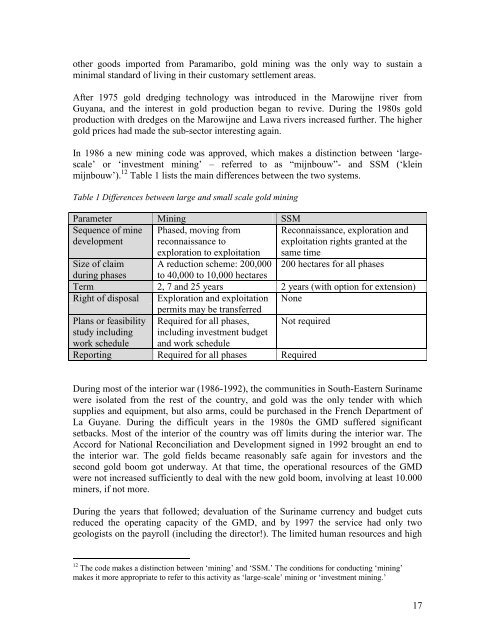SITUATION ANALYSIS OF THE SMALL-SCALE GOLD ... - WWF
SITUATION ANALYSIS OF THE SMALL-SCALE GOLD ... - WWF
SITUATION ANALYSIS OF THE SMALL-SCALE GOLD ... - WWF
You also want an ePaper? Increase the reach of your titles
YUMPU automatically turns print PDFs into web optimized ePapers that Google loves.
other goods imported from Paramaribo, gold mining was the only way to sustain a<br />
minimal standard of living in their customary settlement areas.<br />
After 1975 gold dredging technology was introduced in the Marowijne river from<br />
Guyana, and the interest in gold production began to revive. During the 1980s gold<br />
production with dredges on the Marowijne and Lawa rivers increased further. The higher<br />
gold prices had made the sub-sector interesting again.<br />
In 1986 a new mining code was approved, which makes a distinction between „largescale‟<br />
or „investment mining‟ – referred to as “mijnbouw”- and SSM („klein<br />
mijnbouw‟). 12 Table 1 lists the main differences between the two systems.<br />
Table 1 Differences between large and small scale gold mining<br />
Parameter Mining SSM<br />
Sequence of mine<br />
development<br />
Phased, moving from<br />
reconnaissance to<br />
exploration to exploitation<br />
A reduction scheme: 200,000<br />
to 40,000 to 10,000 hectares<br />
Reconnaissance, exploration and<br />
exploitation rights granted at the<br />
same time<br />
200 hectares for all phases<br />
Size of claim<br />
during phases<br />
Term 2, 7 and 25 years 2 years (with option for extension)<br />
Right of disposal Exploration and exploitation<br />
permits may be transferred<br />
None<br />
Plans or feasibility Required for all phases, Not required<br />
study including including investment budget<br />
work schedule and work schedule<br />
Reporting Required for all phases Required<br />
During most of the interior war (1986-1992), the communities in South-Eastern Suriname<br />
were isolated from the rest of the country, and gold was the only tender with which<br />
supplies and equipment, but also arms, could be purchased in the French Department of<br />
La Guyane. During the difficult years in the 1980s the GMD suffered significant<br />
setbacks. Most of the interior of the country was off limits during the interior war. The<br />
Accord for National Reconciliation and Development signed in 1992 brought an end to<br />
the interior war. The gold fields became reasonably safe again for investors and the<br />
second gold boom got underway. At that time, the operational resources of the GMD<br />
were not increased sufficiently to deal with the new gold boom, involving at least 10.000<br />
miners, if not more.<br />
During the years that followed; devaluation of the Suriname currency and budget cuts<br />
reduced the operating capacity of the GMD, and by 1997 the service had only two<br />
geologists on the payroll (including the director!). The limited human resources and high<br />
12 The code makes a distinction between „mining‟ and „SSM.‟ The conditions for conducting „mining‟<br />
makes it more appropriate to refer to this activity as „large-scale‟ mining or „investment mining.‟<br />
17
















